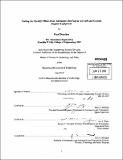Scaling air quality effects from alternative jet fuel in aircraft and ground support equipment
Author(s)
Donohoo-Vallett, Pearl Elizabeth
DownloadFull printable version (12.43Mb)
Other Contributors
Massachusetts Institute of Technology. Technology and Policy Program.
Advisor
James I. Hileman.
Terms of use
Metadata
Show full item recordAbstract
Many of the nation's largest airports, including Los Angeles International Airport, the Hartsfield-Jackson Atlanta International Airport, Chicago O'Hare International Airport and Washington Dulles International Airport are located within areas designated by the EPA as having ambient particulate matter concentrations that exceed National Ambient Air Quality standards. When inhaled, fine particulate matter can enter the blood stream from the lungs and increase the risk of illness and premature mortality. This thesis examines the potential of two jet fuel types, ultra low sulfur jet fuel and synthetic paraffinic kerosene, to reduce aviation's contribution to ambient particulate matter concentrations. Scaling factors were developed for airport criteria pollutant emissions to model alternative jet fuels in aircraft and ground support equipment. These linear scaling factors were based on currently published studies comparing standard diesel and jet fuels with alternative jet fuels. It was found that alternative jet fuels lower or maintain all air pollutant emissions considered (primary particulate matter, sulfur oxides, nitrous oxides, unburned hydrocarbons and carbon monoxide) for both aircraft and ground support equipment. To quantify the potential benefits of changing fuel composition on ambient particulate matter concentrations, a study of the Atlanta Hartsfield Jackson International Airport was completed using both emissions inventory analysis and atmospheric modeling. The atmospheric modeling captures both primary particulate matter and other emissions that react in the atmosphere to form secondary particulate matter. It was found that the use of an ultra low sulfur jet fuel in aircraft gas turbines could reduce the primary particulate matter inventory by 37% and synthetic paraffinic kerosene could reduce the primary particulate matter inventory by 64%. The atmospheric modeling predicts that an ultra low sulfur jet fuel in aircraft could reduce ambient particulate matter concentrations due to aircraft by up to 57% and synthetic paraffinic kerosene could reduce particulate matter concentrations due to aircraft by up to 67%. Thus, this study indicates that the majority of air quality benefits at Atlanta Hartsfield Jackson International Airport that could be derived from the two fuels considered can be captured by removing the sulfur from jet fuel through the use of an ultra low sulfur jet fuel.
Description
Thesis (S.M. in Technology and Policy)--Massachusetts Institute of Technology, Engineering Systems Division, Technology and Policy Program, 2010. Cataloged from PDF version of thesis. Includes bibliographical references (p. 74-78).
Date issued
2010Department
Massachusetts Institute of Technology. Engineering Systems DivisionPublisher
Massachusetts Institute of Technology
Keywords
Engineering Systems Division., Technology and Policy Program.